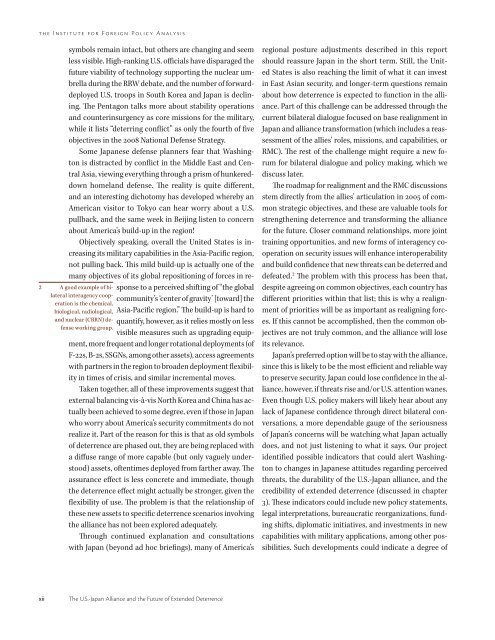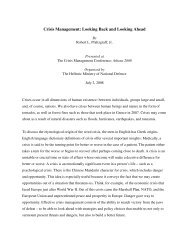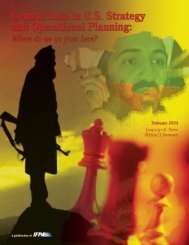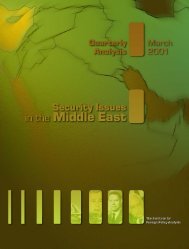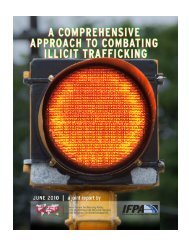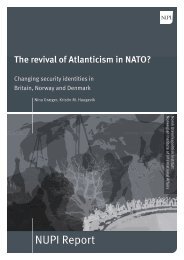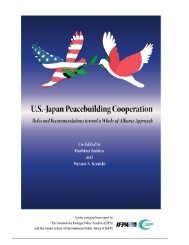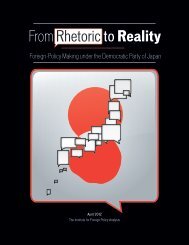Realigning Priorities: The U.S.-Japan Alliance and the Future of ...
Realigning Priorities: The U.S.-Japan Alliance and the Future of ...
Realigning Priorities: The U.S.-Japan Alliance and the Future of ...
Create successful ePaper yourself
Turn your PDF publications into a flip-book with our unique Google optimized e-Paper software.
t h e I n s t i t u t e f o r F o r e i g n P o l i c y A n a ly s i s<br />
symbols remain intact, but o<strong>the</strong>rs are changing <strong>and</strong> seem<br />
less visible. High-ranking U.S. <strong>of</strong>ficials have disparaged <strong>the</strong><br />
future viability <strong>of</strong> technology supporting <strong>the</strong> nuclear umbrella<br />
during <strong>the</strong> RRW debate, <strong>and</strong> <strong>the</strong> number <strong>of</strong> forwarddeployed<br />
U.S. troops in South Korea <strong>and</strong> <strong>Japan</strong> is declining.<br />
<strong>The</strong> Pentagon talks more about stability operations<br />
<strong>and</strong> counterinsurgency as core missions for <strong>the</strong> military,<br />
while it lists “deterring conflict” as only <strong>the</strong> fourth <strong>of</strong> five<br />
objectives in <strong>the</strong> 2008 National Defense Strategy.<br />
Some <strong>Japan</strong>ese defense planners fear that Washington<br />
is distracted by conflict in <strong>the</strong> Middle East <strong>and</strong> Central<br />
Asia, viewing everything through a prism <strong>of</strong> hunkereddown<br />
homel<strong>and</strong> defense. <strong>The</strong> reality is quite different,<br />
<strong>and</strong> an interesting dichotomy has developed whereby an<br />
American visitor to Tokyo can hear worry about a U.S.<br />
pullback, <strong>and</strong> <strong>the</strong> same week in Beijing listen to concern<br />
about America’s build-up in <strong>the</strong> region!<br />
Objectively speaking, overall <strong>the</strong> United States is increasing<br />
its military capabilities in <strong>the</strong> Asia-Pacific region,<br />
not pulling back. This mild build-up is actually one <strong>of</strong> <strong>the</strong><br />
many objectives <strong>of</strong> its global repositioning <strong>of</strong> forces in response<br />
to a perceived shifting <strong>of</strong> “<strong>the</strong> global<br />
community’s ‘center <strong>of</strong> gravity’ [toward] <strong>the</strong><br />
Asia-Pacific region.” <strong>The</strong> build-up is hard to<br />
quantify, however, as it relies mostly on less<br />
visible measures such as upgrading equipment,<br />
more frequent <strong>and</strong> longer rotational deployments (<strong>of</strong><br />
F-22s, B-2s, SSGNs, among o<strong>the</strong>r assets), access agreements<br />
with partners in <strong>the</strong> region to broaden deployment flexibility<br />
in times <strong>of</strong> crisis, <strong>and</strong> similar incremental moves.<br />
Taken toge<strong>the</strong>r, all <strong>of</strong> <strong>the</strong>se improvements suggest that<br />
external balancing vis-à-vis North Korea <strong>and</strong> China has actually<br />
been achieved to some degree, even if those in <strong>Japan</strong><br />
who worry about America’s security commitments do not<br />
realize it. Part <strong>of</strong> <strong>the</strong> reason for this is that as old symbols<br />
<strong>of</strong> deterrence are phased out, <strong>the</strong>y are being replaced with<br />
a diffuse range <strong>of</strong> more capable (but only vaguely understood)<br />
assets, <strong>of</strong>tentimes deployed from far<strong>the</strong>r away. <strong>The</strong><br />
assurance effect is less concrete <strong>and</strong> immediate, though<br />
<strong>the</strong> deterrence effect might actually be stronger, given <strong>the</strong><br />
flexibility <strong>of</strong> use. <strong>The</strong> problem is that <strong>the</strong> relationship <strong>of</strong><br />
<strong>the</strong>se new assets to specific deterrence scenarios involving<br />
<strong>the</strong> alliance has not been explored adequately.<br />
Through continued explanation <strong>and</strong> consultations<br />
with <strong>Japan</strong> (beyond ad hoc briefings), many <strong>of</strong> America’s<br />
2 A good example <strong>of</strong> bilateral<br />
interagency cooperation<br />
is <strong>the</strong> chemical,<br />
biological, radiological,<br />
<strong>and</strong> nuclear (CBRN) defense<br />
working group.<br />
regional posture adjustments described in this report<br />
should reassure <strong>Japan</strong> in <strong>the</strong> short term. Still, <strong>the</strong> United<br />
States is also reaching <strong>the</strong> limit <strong>of</strong> what it can invest<br />
in East Asian security, <strong>and</strong> longer-term questions remain<br />
about how deterrence is expected to function in <strong>the</strong> alliance.<br />
Part <strong>of</strong> this challenge can be addressed through <strong>the</strong><br />
current bilateral dialogue focused on base realignment in<br />
<strong>Japan</strong> <strong>and</strong> alliance transformation (which includes a reassessment<br />
<strong>of</strong> <strong>the</strong> allies’ roles, missions, <strong>and</strong> capabilities, or<br />
RMC). <strong>The</strong> rest <strong>of</strong> <strong>the</strong> challenge might require a new forum<br />
for bilateral dialogue <strong>and</strong> policy making, which we<br />
discuss later.<br />
<strong>The</strong> roadmap for realignment <strong>and</strong> <strong>the</strong> RMC discussions<br />
stem directly from <strong>the</strong> allies’ articulation in 2005 <strong>of</strong> common<br />
strategic objectives, <strong>and</strong> <strong>the</strong>se are valuable tools for<br />
streng<strong>the</strong>ning deterrence <strong>and</strong> transforming <strong>the</strong> alliance<br />
for <strong>the</strong> future. Closer comm<strong>and</strong> relationships, more joint<br />
training opportunities, <strong>and</strong> new forms <strong>of</strong> interagency cooperation<br />
on security issues will enhance interoperability<br />
<strong>and</strong> build confidence that new threats can be deterred <strong>and</strong><br />
defeated. 2 <strong>The</strong> problem with this process has been that,<br />
despite agreeing on common objectives, each country has<br />
different priorities within that list; this is why a realignment<br />
<strong>of</strong> priorities will be as important as realigning forces.<br />
If this cannot be accomplished, <strong>the</strong>n <strong>the</strong> common objectives<br />
are not truly common, <strong>and</strong> <strong>the</strong> alliance will lose<br />
its relevance.<br />
<strong>Japan</strong>’s preferred option will be to stay with <strong>the</strong> alliance,<br />
since this is likely to be <strong>the</strong> most efficient <strong>and</strong> reliable way<br />
to preserve security. <strong>Japan</strong> could lose confidence in <strong>the</strong> alliance,<br />
however, if threats rise <strong>and</strong>/or U.S. attention wanes.<br />
Even though U.S. policy makers will likely hear about any<br />
lack <strong>of</strong> <strong>Japan</strong>ese confidence through direct bilateral conversations,<br />
a more dependable gauge <strong>of</strong> <strong>the</strong> seriousness<br />
<strong>of</strong> <strong>Japan</strong>’s concerns will be watching what <strong>Japan</strong> actually<br />
does, <strong>and</strong> not just listening to what it says. Our project<br />
identified possible indicators that could alert Washington<br />
to changes in <strong>Japan</strong>ese attitudes regarding perceived<br />
threats, <strong>the</strong> durability <strong>of</strong> <strong>the</strong> U.S.-<strong>Japan</strong> alliance, <strong>and</strong> <strong>the</strong><br />
credibility <strong>of</strong> extended deterrence (discussed in chapter<br />
3). <strong>The</strong>se indicators could include new policy statements,<br />
legal interpretations, bureaucratic reorganizations, funding<br />
shifts, diplomatic initiatives, <strong>and</strong> investments in new<br />
capabilities with military applications, among o<strong>the</strong>r possibilities.<br />
Such developments could indicate a degree <strong>of</strong><br />
xii<br />
<strong>The</strong> U.S.-<strong>Japan</strong> <strong>Alliance</strong> <strong>and</strong> <strong>the</strong> <strong>Future</strong> <strong>of</strong> Extended Deterrence


